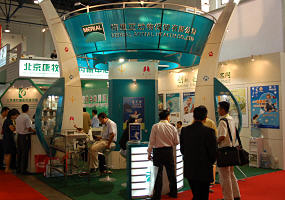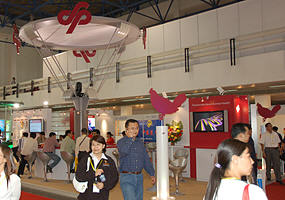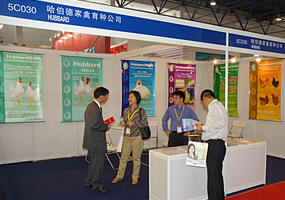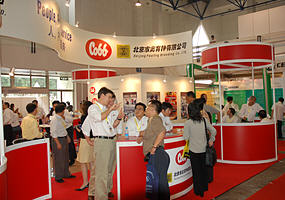



A golden season for China's livestock
CHINA - A pillar for the nation's agriculture and rural development, China's animal husbandry sector is today one of the world's most important not only because of its sheer output volume, but also in terms of its role in feeding the planet's most populous nation.
CHINA - A pillar for the nation's agriculture and rural development, China's animal husbandry sector is today one of the world's most important not only because of its sheer output volume, but also in terms of its role in feeding the planet's most populous nation.  To keep the industry growing in the right direction, the industry will need strong political backing even as a healthy economy continues to propel upwards demand for livestock and meat products, say VIPs and speakers at last week's VIV China exhibition, which opened Sep 27 at the Beijing-based China International Exhibition Centre just before the golden week holiday commemorating China's National Day on Oct 1.
To keep the industry growing in the right direction, the industry will need strong political backing even as a healthy economy continues to propel upwards demand for livestock and meat products, say VIPs and speakers at last week's VIV China exhibition, which opened Sep 27 at the Beijing-based China International Exhibition Centre just before the golden week holiday commemorating China's National Day on Oct 1.

Opening Ceremony of VIV China 2006
Besides boasting some of the world's record levels of livestock production, growing appetites for meat mean that China is also fast becoming a lucrative export market, hence the lure of international livestock events like VIV China. Some 143 non-Chinese companies from over 25 countries, representing a third of the 426 exhibitors, participated at this year's three-day show, which was spread over five halls at a total of 8,400 sq metres.
A case in point is the pig industry, where China leads the world with half of the global pig population. Chris Jackson, export promoter for the British Pig Association (BPA), is confident not only of the potential of the Chinese market, but also enthuses that British pig breeds are at the threshold of a grand new chapter of growth in demand in China.
He is not without reason. Since a 1996 ban on live pigs from the UK due to disease concerns was lifted last year, the UK has begun fervently promoting its pig breeds to Chinese breeders. A brood of Large White pigs currently under quarantine in Beijing may well signal the first of many such imports to come, says Jackson, who reveals that the pigs were confirmed for shipment to China within a week of getting the trade protocols in place.
He also enthuses that the 20 years of pig trade between the UK and China prior to 1996 is on the verge of a monumental take-off "once Chinese producers witness for themselves the high standards and quality of our breeds." Jackson also sees no threat coming from Canadian, French, Belgian, Swedish or Danish pig breeds, as UK breeds like the Yorkshire, Landrace, Duroc and Large White are "so good that they are simply everywhere in the world".
Wang Bing, deputy manager of import and export at SinoFarm Genetics and Seeds, the company that brought the pigs in, similarly praises UK pig breeds for their high performance characteristics and adaptability. After a visit organised by the BPA to several pig sites in the UK, Wang began liaising with pig breeding company Hermitage Seaborough to bring in China's first batch of Large White pigs from the UK since 1996.
More of such specially-organised field trips, talks on UK pig breeds such as the one presented by Jackson himself during the CEO Seminar on Sep 26 in Beijing a day before VIV China and a seminar to be held in Shanghai later in the year are ways in which the BPA promotes the export potential of UK pigs to China. Julia Chang of the British Trade and Cultural Office in Taiwan says that part of the strategy is also to get more UK pig breeding companies to showcase their breeds in exhibitions like VIV China and bring these companies on farm visits around China as well as elsewhere in Asia.
With dairy production in China registering a 25-percent per annum growth between 2004 and 2005, dairy and ruminant production was a key focus at VIV China, which this year hosted a milk pavilion for the first time.
China's top dairy and beef regions are mainly in the north, in the provinces of Hebei, Xinjiang, Heilongjiang and Inner Mongolia; the latter, owing to a vast grassland typography, is the country's top dairy region. John Jiang, Nutrifeed's chief area representative based in Shanghai for its ruminant business, says that small cattle raising facilities are currently moving towards privatisation or state-ownership, where the trend for medium and commercial farms, rather than small household-run farms, dominating China's ruminant industry, is becoming more apparent.
VIV China 2006 ended Sep 29 and will be next held in Beijing on Sep 26-28, 2008. The event was sponsored by the National Animal Husbandry Service and co-organised by VNU Exhibitions and the Beijing Tech Convention and Exhibition Centre. eFeedLink Singapore, together with its sister company, Shanghai eFeedLink Information technology, was among the exhibitors at the trade event.

Opening Ceremony of VIV China 2006
Besides boasting some of the world's record levels of livestock production, growing appetites for meat mean that China is also fast becoming a lucrative export market, hence the lure of international livestock events like VIV China. Some 143 non-Chinese companies from over 25 countries, representing a third of the 426 exhibitors, participated at this year's three-day show, which was spread over five halls at a total of 8,400 sq metres.
A case in point is the pig industry, where China leads the world with half of the global pig population. Chris Jackson, export promoter for the British Pig Association (BPA), is confident not only of the potential of the Chinese market, but also enthuses that British pig breeds are at the threshold of a grand new chapter of growth in demand in China.
He is not without reason. Since a 1996 ban on live pigs from the UK due to disease concerns was lifted last year, the UK has begun fervently promoting its pig breeds to Chinese breeders. A brood of Large White pigs currently under quarantine in Beijing may well signal the first of many such imports to come, says Jackson, who reveals that the pigs were confirmed for shipment to China within a week of getting the trade protocols in place.
He also enthuses that the 20 years of pig trade between the UK and China prior to 1996 is on the verge of a monumental take-off "once Chinese producers witness for themselves the high standards and quality of our breeds." Jackson also sees no threat coming from Canadian, French, Belgian, Swedish or Danish pig breeds, as UK breeds like the Yorkshire, Landrace, Duroc and Large White are "so good that they are simply everywhere in the world".
Wang Bing, deputy manager of import and export at SinoFarm Genetics and Seeds, the company that brought the pigs in, similarly praises UK pig breeds for their high performance characteristics and adaptability. After a visit organised by the BPA to several pig sites in the UK, Wang began liaising with pig breeding company Hermitage Seaborough to bring in China's first batch of Large White pigs from the UK since 1996.
More of such specially-organised field trips, talks on UK pig breeds such as the one presented by Jackson himself during the CEO Seminar on Sep 26 in Beijing a day before VIV China and a seminar to be held in Shanghai later in the year are ways in which the BPA promotes the export potential of UK pigs to China. Julia Chang of the British Trade and Cultural Office in Taiwan says that part of the strategy is also to get more UK pig breeding companies to showcase their breeds in exhibitions like VIV China and bring these companies on farm visits around China as well as elsewhere in Asia.
With dairy production in China registering a 25-percent per annum growth between 2004 and 2005, dairy and ruminant production was a key focus at VIV China, which this year hosted a milk pavilion for the first time.
China's top dairy and beef regions are mainly in the north, in the provinces of Hebei, Xinjiang, Heilongjiang and Inner Mongolia; the latter, owing to a vast grassland typography, is the country's top dairy region. John Jiang, Nutrifeed's chief area representative based in Shanghai for its ruminant business, says that small cattle raising facilities are currently moving towards privatisation or state-ownership, where the trend for medium and commercial farms, rather than small household-run farms, dominating China's ruminant industry, is becoming more apparent.
VIV China 2006 ended Sep 29 and will be next held in Beijing on Sep 26-28, 2008. The event was sponsored by the National Animal Husbandry Service and co-organised by VNU Exhibitions and the Beijing Tech Convention and Exhibition Centre. eFeedLink Singapore, together with its sister company, Shanghai eFeedLink Information technology, was among the exhibitors at the trade event.
A few photos from the event
 |
 |
|
 |
 |
|
 |
 |
|
 |
 |
<?=getCodeSnippet(49);?>








